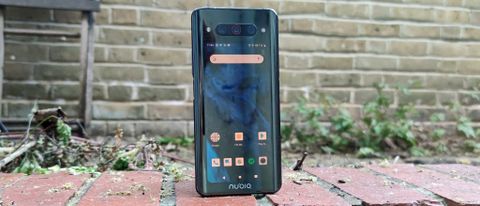TechRadar Verdict
The Nubia Z20’s second screen may not add a whole lot to the device, but the phone doesn’t really need it – it’s a fine mid-range phone with a great main screen, useful cameras, and snappy processing speed. Most users might find they’re paying for a screen they don’t use, though, so we can’t recommend it for everyone.
Pros
- +
Great-looking screen
- +
Decent camera array
- +
Impressive chipset
Cons
- -
Battery leaves a lot to be desired
- -
Second screen doesn’t revolutionize experience
- -
No headphone jack
Why you can trust TechRadar
Two-minute review
The Nubia Z20 has a screen on the front and another, smaller one on the rear. Is this an attempt to increase screen space, like dual-display devices or foldable phones? Or a solution to the full-screen ‘problem’? (As the smaller screen is nestled under the rear camera array, so there’s no need for a snapper on the front). Perhaps it’s both.
The Nubia Z20, from tech company ZTE, is partly the successor to the Nubia Z18, as part of the brand’s confusingly-named range, but it’s similar to the Nubia X from 2018 which also had a screen on the back.
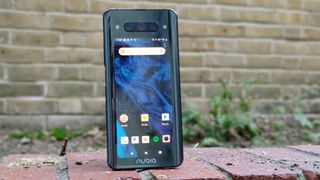
Price and availability
Design
Display
Camera
Performance and software
Battery life
Should I buy it?
It’s easy to pigeon-hole the ZTE Nubia Z20 as ‘the phone with a screen on the back’, and it’s certainly an interesting gimmick, but to condense the handset down to this one feature is to ignore all its other strengths.
The phone has a three-camera array led by a 48MP sensor; this isn’t just an attempt for the device to look good on paper, either, as the Z20 takes good-looking pictures with that snapper as well as its ultra-wide and telephoto siblings. These snappers double as your selfie cameras too, although curiously when in selfie-mode some of the modes are absent.
The main display and chipset are good too, especially for the price tag, which is decidedly mid-range. So you’d have a good time with the Nubia Z20 whether or not you use the second screen, although whether you’ll be happy paying for this extra display is another matter entirely.
ZTE Nubia Z20 price and availability
- Nubia Z20 launched in late 2019
- Costs $549 / £499 / AU$670
- Not available from carriers
The ZTE Nubia Z20 is available to buy for $549 / £499 / AU$670, so it’s a decently-priced mid-range phone, and you can pick it up for a similar price to some of its contemporaries like the OnePlus 7T ($499 / £469, roughly AU$750).
The phone is available from Nubia’s website as well as Amazon, though we haven’t seen any carriers selling it, so you may have to pick it up SIM-free. It was made available at the end of 2019.
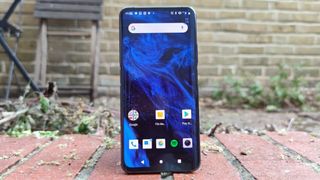
Design
- Two side-mounted fingerprint sensors
- USB-C port but no 3.5mm headphone jack
- Feels robust and good to hold
The Nubia Z20 has a screen on both sides of the device, but we’ll refer to the ‘front’ as the side without the camera array on it. This side has a screen taking up the majority of the space, although there’s a bit more bezel around the sides than on a more premium device. This display is also curved, lending a high-end feel to the phone.
On the back there’s the smaller screen, housed under a horizontal camera bump (although ‘bump’ might be an exaggeration, since it barely sticks out from the back of the phone). Then, in the chin under this second display, is Nubia’s logo.
An interesting design aspect of the Nubia Z20 is that there’s a side-mounted fingerprint sensor on both sides of the device. Not only does this make it easy to unlock the screen whether you’re using the front or back display, but it’s also very useful for left-handed people who want to pick up and unlock the device with their primary hand.
These side fingerprint sensors also double as the power button, so it’s incredibly easy to unlock the device, and we’re big fans of phones that use this method of opening (the Honor 20 for example also has a side-mounted scanner/power button combo).
On the right hand side of the phone (when you’re looking at the primary screen) there’s also a volume rocker, just above the fingerprint sensor.

There’s a USB-C port at the bottom of the handset, but no 3.5mm headphone jack, so if you’re a fan of wired headphones you’ll have to use the adapter in the box.
You’d expect a phone bedecked with multiple screens to feel pretty fragile, but the Nubia Z20 felt particularly robust, and in our time with the phone we never felt at risk of damaging it. It’s likely not compatible with many cases though.
Display
- 6.42-inch AMOLED screen joined by 5.1-inch second screen
- Main screen generally looks good
- Curved main screen has extra functions
The ZTE Nubia Z20’s ‘front’ display is a 6.42-inch AMOLED screen, with a 1080 x 2340 resolution and HDR10. Content viewed on this is pretty good looking, thanks to the resolution and the AMOLED screen tech, which really makes colors pop.
There’s an impressive collection accessibility features present in the device too, thanks to the display. For example, if you squeeze the phone (and therefore tap both sides of the curved display), you trigger a mappable function (which we choose to use to access the camera). This turns a common gripe with curved-screen phones into a useful function.
There are also gestures that change how you switch between the different screens, either by tilting the phone or tapping a certain button, and the option of an always-on display for either the front or back panel. However, we never managed to actually get this latter feature to work.

Then on the back there’s a 5.1-inch AMOLED screen with a 720 x 1520 resolution, and as those specs suggest this isn’t exactly the best for viewing content, compared to the front display. This was a little bit of an issue for certain functions of the second screen, but wasn’t too bad for others.
A common question we were asked when testing the ZTE Nubia Z20 was ‘why do you need two screens?’, and after using the device for a few weeks we have a few answers, although we’re not sure if any of them justify the extra cost of it.
The main use of the second screen is so you can use the rear camera array to take selfies, and while the display is a little too small and low-res to make this as convenient as using a standard front-facing selfie-cam, it still works.
A much more practical use is the ability to send notifications to the rear screen, or open separate apps on it to the front screen. This makes it easy to deal with a message, for example, or temporarily jump to a second app without disrupting work on the first.
For example, when taking a flight we delegated our digital boarding pass to the second screen, so when we needed it we could easily turn the phone over and have the boarding pass ready, without having to worry about finding it.
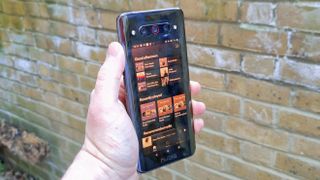
Sure, these functions are quite convenient, as is viewfinder mode in the camera app, which lets the subject of pictures see what you’re snapping, and we enjoyed the ability to use them, but we’re not sure the possibility would be a big enough draw to convince someone to buy the handset.
Camera
- 48MP main, 8MP telephoto, 16MP ultra-wide camera
- These are also your selfie cameras
- Good hardware is matched by okay software
The main camera on the ZTE Nubia Z20 is a 48MP f/1.7 one, and it’s joined by an 8MP f/2.4 telephoto shooter which supports 3x optical zoom, and a 16MP f/2.2 ultra-wide camera.
These are, of course, also the cameras you use for selfies, although curiously most of the functions of the rear cameras aren’t available when you press that ‘switch’ button in the camera to activate the rear screen to take selfies.
You can work around this, by toggling the viewfinder function which lets you see on the rear screen what you’re about to take a picture of, then using the volume rocker as a shutter button. However this is a bit of a pain, and we wish the functions would be available even in selfie mode.
Our brief sweeping statement on the Nubia Z20’s cameras is that the hardware is pulling all the weight, while the software lets the side down a little bit. This results in pictures that are still good, which is why ‘decent camera array’ is in our list of pros, but ‘decent’ isn’t quite ‘amazing’.
Pictures taken with the ultra-wide, main and telephoto cameras are all decent, with little to no distortion on the ulta-wide (whereas some such lenses create pictures that are rippled at the sides) and good quality even when zoomed on the telephoto (another issue some phone cameras have). Colors on photos look a little pale, but nothing to turn your nose up at.
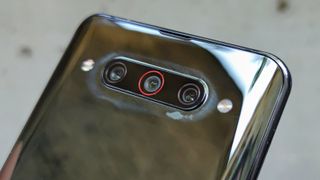
However where another smartphone camera might have software that makes decent pictures great, there isn’t too much software at work in the ZTE Nubia Z20, which means those decent pictures stay at just that.
As a result, colors don’t really pop as much as they should, and images ended up a little duller than we’d have liked.
The fact the software is the main issue is also evident when looking at different camera modes. For example, both Portrait and Night modes don’t make a huge difference to shots generally.
If you find the right subject and framing, then you can take Portrait shots that effectively blur the background but not the subject, or Night shots that are noticeably brighter, but after lots of testing we only took a few shots where these option modes made much of a difference.
Unlike hardware, software can be changed by a company over time, so it’s possible that with updates and tweaks the ZTE Nubia Z20 will take great pictures. But at the time of testing, the photos we could take were good, not great.
If you like video recording, you might be in for a shock with the Nubia Z20, because not only can you shoot in 4K 60fps (a rarity in mid-range smartphones), there’s actually an 8K shooting mode, technically making the phone beat the Samsung Galaxy S20 and Xiaomi Mi 10 to be the first with this feature, as it launched before those phones.
This 8K mode isn’t something we’d recommend though, as the frame rate was incredibly low, so videos shot are honestly pretty hard to watch. Videos shot in 4K, or even 1080p, were fine for use though, and it’s unlikely you’ll even have a screen that can display 8K content.
Camera samples

Shot with the main camera

Shot with the zoom camera

Shot with the ultra-wide camera

Shot with the main camera in portrait mode

Shot with the night mode
Performance and software
- Snapdragon 855 Plus chipset, 8GB RAM
- Android 9 with Nubia UI 7 laid over the top
- Second-screen button can get in the way
The ZTE Nubia Z20 comes with the Snapdragon 855 Plus chipset, which was the top Android chipset available when it was released (although in early 2020 phones started coming with its successor, the 865). This provides some pretty decent processing power, as you’d imagine. It’s paired with 8GB RAM and 128GB storage.
In a Geekbench 5 benchmarking test, the ZTE Nubia Z20 returned a multi-core score of 2,411, beating 2019 phones like the Samsung Galaxy S10 range, but not quite matching the Sony Xperia 5 or OnePlus 7T Pro, which were just ahead.
With the Nubia Z20, though, you’re not going to be pining for more processing power, because it’s just fine as is. Games ran smooth on high graphics, and we never had an issue with lagging or slow loading.
The Nubia Z20 runs Android 9, with Nubia UI 7 laid over the top, and of all the Chinese-made custom UIs that run on phones from the likes of Xiaomi, Huawei and Oppo, this is definitely one of the best – it’s free of annoying bloatware, easy to navigate, and with a settings menu that’s a lot more logically laid out than on many other handsets.
One slight issue though is the ‘second-screen button’, which is always present on the screen. You can choose what this does, depending on how you toggle the second screen: if you select the option that lets you tilt the main screen forward to open the second screen, this button locks that function so you can’t accidentally switch screens, but you can also make the button simply open the second screen if you find this an easier way of getting the second screen working.

Either way, the button is always on the screen, and while you can drag it about to move it out the way, we often found it a little annoying having to move the icon around depending on what we were doing. Perhaps a physical button to change screens would have been more convenient.
If you choose the aforementioned ‘tilt’ way of switching screens, the phone can sometimes be a little oversensitive and swap screens even when you don’t want it to, so we’d recommend staying in lock mode if you don’t want this other display turning off and on.
Battery life
- 4,000mAh battery
- Phone didn't always last a full day
- 27W fast charge took less than an hour to get to 100%
The Nubia Z20 has a 4,000mAh battery, which is a fair size for a mid-range smartphone, although we came to wish the power pack was a little bigger, as it didn’t last us as long as we’d like.
With light use, the phone could make it through a day, but if we were to play games, stream content, or spend lots of time on social media, we’d usually have to top the phone up towards the end of the day.
This relatively short battery life is likely a result of the high screen quality, and when we used the second screen for day-to-day activities instead it did feel like the battery was lasting a little better, likely thanks to its smaller size and lower resolution.
Charging is done with 27W fast charging, which feels rather standard for a smartphone at this price point. It will get your phone fully charged in less than an hour, but since the battery life isn’t great this powering speed feels like the bare minimum.
Should I buy the ZTE Nubia Z20?

Buy it if
You think the second screen looks interesting
The Nubia Z20 is certainly an interesting party piece, and people will be drawn by ‘the weird phone with two screens’. As stated, there are a few useful functions for it too, and some people might find this a good enough reason to buy the phone.
You want a good mid-range phone
All things considered, the ZTE Nubia Z20 is a decent phone for its price regardless of the gimmick, as its screen quality, camera capability, and processing power are all what you’d expect for the price tag. You won’t feel let down by the Nubia Z20 at all.
You’re left-handed
Most smartphones are designed with right-handed people in mind, with the buttons and often the fingerprint scanner being on the right edge of the device. With two fingerprint scanners, left-handed people can get in on the action here too.
Don’t buy it if
You think you’d get bored of the second screen
While some people might find the second screen really useful, others might quickly forget about it, so if you can’t imagine a plausible use case for this diminutive display, you might want to look at phones with similar specs that don’t have this second screen but cost less as a result.
You want fantastic cameras
As we’ve stated, the Nubia Z20 has good cameras, but they fall shy of greatness, and at this same price tag you might find other smartphones that have it beat in terms of photographic potential, like certain Honor phones. Those competitors might not give you a 48MP selfie camera, though.
A long battery life is vital
The Nubia Z20 doesn’t have the best battery life in the world, and you’d be hard pressed to get it to last for a full day without modifying your use of it in some way. The charging speed isn’t fantastic either, although it’s about average for a phone at this price.

Tom Bedford was deputy phones editor on TechRadar until late 2022, having worked his way up from staff writer. Though he specialized in phones and tablets, he also took on other tech like electric scooters, smartwatches, fitness, mobile gaming and more. He is based in London, UK and now works for the entertainment site What To Watch.
He graduated in American Literature and Creative Writing from the University of East Anglia. Prior to working on TechRadar, he freelanced in tech, gaming and entertainment, and also spent many years working as a mixologist. He also currently works in film as a screenwriter, director and producer.
